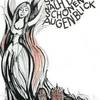History of Tangermünde
Tangermünde is one of those towns which have preserved their medieval appearance until today. Coming over the Elbe Bridge, you can see the town from its most beautiful side. On a plateau over the river Tanger's mouth into the river Elbe, is an ancient castle and the town of Tangermünde which was built about 800 years ago and came under the protection of the castle. St. Stephan's church, with its 86 m steeple (It is presently being restored and stands next to the church), towers over the city. Around the church there are many towers and town houses. Everything is surrounded by the town wall and you can see the red colour of the bricks being reflected in the river Tanger's water.
In 1009 Tangermünde castle was mentioned by chroniclers for the first time. During the first half of the 13th century the former market town became the town Tangermünde.
In 1373 Karl IV, Bohemian king and German emperor, acquired the Mark Brandenburg.
Accompanied by a big entourage, he entered Tangermünde castle on September 7th 1373 and turned it into his second residence. Karl IV., who is also called the merchant among the emperors, increased his wealth especially by his business ability. Through the Hanseatic town Tangermünde, he expected profitable relations to the powerful Hanseatic League. When Karl IV. passed away in 1378, the idea of Tangermünde playing an important role in history also died. As Sigismund, Karl's under-age son at this time, was not very interested in the Altmark, there was a growing disorder. This situation did not change under the reign of Jobst from Moravia. Later, the Hohenzollern resided in Tangermünde for several decades. But the relation between the inhabitants of Tangermünde and the Hohenzollern was not as peaceful as life under Karl IV had been. Finally, in 1488 Elector Johann Cicero moved his residence to Berlin - Cölln.
However, during the 15th century the town was in its heyday. Splendid brick buildings such as the town hall and the town gates were built and the rebuilding of St. Stephan's church was carried on. Even today you can recognize the wealth of the former Hanseatic town Tangermünde by these buildings.
The beginning of the 17th century was the end of the flourishing trading town. The people of Tangermünde suffered from the consequences of several fires, the Thirty Year's War and the plague. The great fire from 1617 destroyed two thirds of the town's buildings. In 1619, Margarete Minde was sentenced to death by burning at the stake after having been extorted the confession under torture. During the following centuries, again and again artists concerned themselves with these events around the fire and the destiny of Grete Minde. At the end of the 17th century, Tangermünde was a minor town in the country, which was not able to recover economically for centuries.
Despite poverty and hardship, several half-timbered houses with beauiful portals and ornament were built in this fateful century.
In the 19th century the existing ancient buildings and the town wall did not have to give way to the beginning industrialisation as it took place especially in the north of the town. Also, the Second World War left only little traces behind. In this way Tangermünde could preserve its original townscape until today. You can comprehend the history by walking around the town and visiting one of our museums. The Heimatmuseum (museum of local history) in the town hall tells you about the chequered history of the town until 1900.
The Burgmuseum (castle museum) in the Tangermünde Schloßfreiheit was set up in the oldest preserved house (1543). In these premises visitors can familiarize themselves with the castle's history, its functions and importance.
It is also worth to visit the Salzkirche. The building's ambience proves to be the ideal background for your exhibitions. Also, it offers best conditions for musical events.
St. Stephan's church with its excellent acoustics and the Schererorgel, which belongs to the 10 most valuable historical organs, are ideal prerequisites for performances of old and modern church music. From May till Oktober during Saturday afternoons musiclovers can listen to the organ's sounds or enjoy another musical event.
In summer 1998 Tangermünde organized the VI. Internationales Steinbildhauersymposium Sachsen-Anhalt (trl.s note: international symposium of stone sculptors in Sachsen-Anhalt). Eight stone sculptors from four European countries created works of art, which now enrich the cultural climate of the town. The sculptures are put up on different places along the river Elbe what gives this part of the town a special character.





